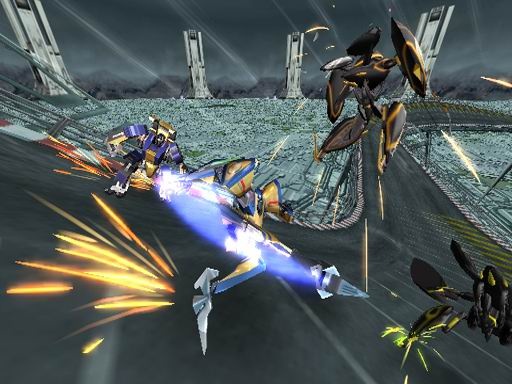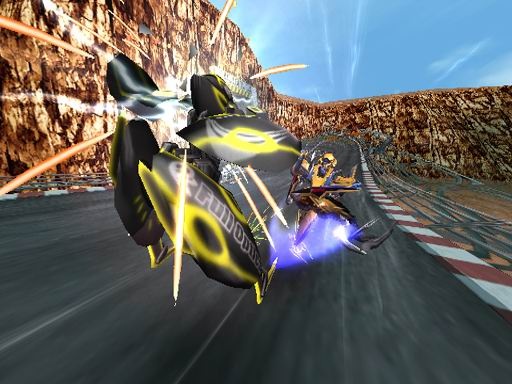Living the immortal life can't be easy. After all, how insanely desensitized do you have to be to resort to battling mechs at unhealthy speeds miles above the Earth's surface just to get your kicks? Actually, IGPX: Immortal Grand Prix isn't really about immortals, and it certainly isn't about a never-ending race, but Namco Bandai clearly knows that a mech-based game that interlaces fighting and racing isn't worth its salt without a little hyperbole thrown into the mix. Unfortunately, what the developer seemingly failed to realize is that to pull off such a crazy concept, it'd need to provide engaging, accessible gameplay and perhaps an enjoyable storyline to accompany it. IGPX doesn't deliver on either count. However, if you can make it past the hideous visuals, baffling control interface, and fragmented story, you just might find a vindictively satisfying mech-combat racing game.

IGPX takes its inspiration from an anime series of the same name, which appears as 26 fully fleshed-out episodes on Cartoon Network. However, Namco Bandai apparently couldn't be bothered with laying any of this backstory out for you, so the most you'll be able to glean from the game is that you take control of Team Satomi, which consists of Takeshi, the talented, brash forward; Liz, the strict, by-the-book defender; and Amy, the hyperintelligent, sympathetic midfielder who works with the sagacious Luca to mastermind the team's strategies. (For what it's worth, Luca is an adorable little kitty.) And in true anime fashion, these youngsters are working their way through the ranks of the Immortal Grand Prix and taking to town teams with far more experience and battle acumen, all through their innate skills and wanton disregard for personal safety. You'll catch bits and pieces of a greater storyline through the repetitive, inane one-liners delivered before each race, but these will never coalesce into anything of significance, nor will they have any impact on the game whatsoever.
Each race consists of the exact same elements. The first lap simply gives you a feel for the course and lets you tweak your game plan and race strategy. You don't have any control over your mech during this lap, but you do adjust your game plan according to whether you want to focus on battle or race, which affects how quickly your respective combo meter and superboost meter fill up. The real action begins on the second lap, which is where you dish out as much damage as possible on the opposing team. Teams consist of three combatants--a lightweight forward, a midsized midfielder, and a heavy-duty defender--that can each take a certain amount of damage before being reduced to a twisted hunk of metal. Races are best won by pounding the other team out of commission, and you'll have the entire second and most of the third lap to do so. Failure to sufficiently thrash your opponents means you'll have to make a mad dash to the finish line in the final stretch of the third lap.
This setup makes the racing aspect secondary to the battling. You're on autopilot for the majority of the race, in the sense that you can't outdistance yourself from the pack. This makes it so the tracks seem to move around you more than you around them, which does free you up to fight, but it also makes all the tracks feel the same since you're not really focusing on their layout. The monotony of the tracks is further aggravated by the fact that you'll be going up against the same few teams over and over again, so there's not much variety from one race to the next. Also, there's no driver skill involved at all, because regardless of how well you race, everyone who's still alive by the time you enter the final stretch enters on the same footing. Another problem here is that it is very easy to win races by just using your superboost, which greatly enhances your speed once per race. Assuming all of your teammates survive, you can simply use the superboost during the final stretch to rocket past the other team, who never seems to use it in any of the leagues. It isn't the least bit fun to win matches this way, and you won't get much money for doing so--but the more lucrative alternative, actually fighting, is a good deal more difficult.
Battling it out in these races can be enjoyable, but a lousy tutorial for an unwieldy control interface makes it incredibly difficult to master. On the surface, fighting is simple and can be accomplished by mashing on the melee attack button. However, trying to straight-up brawl with the other team will result in you inflicting minimal damage since your mechs start out relatively weak. Also, you'll be knocked down repeatedly by the other team's seemingly overpowered special attacks, which they will liberally assault you with. It takes a good deal of practice to perfect the timing of the safe-fall ability, so you'll invariably be taking a lot of damage as you skid across the cold, hard pavement until you can recover from your 350mph wipeout.
Needless to say, fighting can be excessively frustrating for the first few hours of play, until you finally are able to sufficiently upgrade your mech, and, more importantly, figure out and perfect the timing of group combos, as well as come to grips with the occasionally wonky camera angles that they produce. As you do damage, a combo meter at the bottom of your screen fills up, and when it begins to flash you can initiate a group attack that involves hitting an opponent twice and then sending them off to a teammate with the combo button. You can do this multiple times, up until you either miss the combo or hit an opponent three times instead of twice, and it's the best way to do significant unblockable damage. In theory, the practice sounds easy, but even realizing it's a possibility isn't immediately evident, and the tutorial that should clue you in on the how-to of it is an extremely ambiguous, hands-off video, which is really no help at all. This tactic, coupled with the crossfire team stance, which instructs your team to target the opponent with the lowest health, will have you wrecking opponents in short order, and also racking up KO and combo bonuses, which earn you more cash.
As you win races, you'll be able to cash in your winnings for upgraded parts for your mechs, which makes doing damage a lot more practical and makes the game exponentially more enjoyable. Winning races unlocks bigger and better weapons and armor, and the pacing at which the game rolls these out is fairly good. There's a decent selection for each of the four different slots--your right arm, left arm, and legs, as well as a miscellaneous slot--and each piece is rated on a variety of attributes, such as offense, defense, and stability. However, what's annoying about many of the upgrades is that, statistically, the best upgrade for any given slot rarely has a special attack to go along with it. When you're repeatedly getting decimated by the oppositions' special attacks, it can seem cheap and unfair that you aren't also afforded these, and by the time they are included on the good gear, your regular attacks will be powerful enough for the specials to not matter much. On its own, it wouldn't be a big deal, but as it is, it makes starting out all the more frustrating.
When single-player begins to drag, there is a versus mode available. Here, you can build your own dream team by individually selecting specific drivers to compete with or against, or you can duke it out with a friend. However, playing multiplayer IGPX is a mostly futile affair. For one, the game doesn't use a split-screen. Several problems arise from this, the least of which being that your mech flies off the screen when you wipe out, making it difficult to keep track of where you are. Also, you'll have a completely different perspective on the action since the camera will be pulled out much farther to accommodate both players. This jacks your timing for safe-fall recoveries and all the mechs start to blend together, so it can be even more difficult to keep track of where you are in the melee. Also, the button prompts that made combos even remotely possible in the single-player mode aren't displayed, so these attacks will be nearly impossible to do. Since you won't be able to combo and you'll barely know where you are half the time, combat becomes prone to button mashing, which isn't enjoyable in the least.

IGPX would have looked dated coming at the end of the PlayStation cycle, much less the PlayStation 2 cycle; the visuals are easily the worst part about this game. In fact, the game looks like it uses an 8-bit color palette and is riddled with muddy, nondescript textures and poorly detailed backgrounds. The whole point behind gigantic war machines is to make them look freakishly awesome, so the cruddy-looking models on offer here are a huge disservice to mech fans. But at least the collision detection is spot-on, which is essential for a combat game like this, and the frame rate does hold up through some of the more chaotic battle sequences. Also, the game tends to feel fast, especially when you fly over a break in the track while fighting for your life. As for the audio, the hokey voice acting is limited to a few lines that repetitively cycle through the game before each race, and the techno-pop soundtrack does a good job of fading away into white noise to accompany the action.
You won't have any fun with IGPX: Immortal Grand Prix until you master its mostly opaque control interface. And even then, what you'll experience is probably the lowest common denominator of fun. However, getting to the point where you can destroy opposing squads that once reduced you to scrap metal is inexplicably satisfying, though you'll still have to cope with the ugly visuals, repetitive scenarios, and annoying enemy tactics. All told, IGPX has its moments, and it's better than its first impression belies, but ultimately it's too esoteric, ugly, and clunky to recommend.